Physics AS
Introduction Physical Quantities & Base units Vectors & Scalars Kinematics Pressure & Density Dynamics Momentum Energy, power & efficiency Deformation of solids Waves Superposition Stationary waves Electric fields Electricity Circuits & Kirchoff's laws Radioactive Physics AS PracticalPaper 5More
Reference Pastpaper QuestionsDeformation, Elasticity & Elastic Energy
Hooke's law
The force/load is directly proportional to the extension within the limit of proportionality
This is very important
Force = Spring contant * extension
F = kx
So this shows us that the extension changes with the load
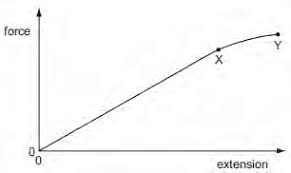
Where x is limit of proportionality and y is the elastic limit
However, when we plot a graph of the load and the (total) length of the wire, it's not directly proportional but, only linear
Spring constant
The force required per unit extension
F/x =k
The spring constant is unique for different springs, when you have different objects they have different spring constants. The spring constant measures how stiff a material is. So greater the spring constants, greater the stiffness
Definition
You will need to know some important terms:
- Hooke's law
- Limit of proportionality
- Plastic deformation
- Elastic deformation
- Elastic limit
Already explained
It is the maximum point where Hooke's law is obeyed and force is directly proportional to the load
It is a deformation which when the load is removed, the object does not return to its original shape, it is permanently deformed
The object returns to its original shape when the load is removed
The maximum point which when exceeded, the object is plastically deformed
Compressive/Tensile forces
We need to know what is the difference between compressive and tensile force
Compressive forces
Compression means squashing so the final lenght is actually less than the original length.
Tensile
Stretching, the final length is larger than the original length
Elastic potential energy
This is same as work done. However, we come to realise that the force changes with the extension, more force is required to extend it
So we take the average force ( (Max + Min)/2 )
Elastic potential energy = Average force * extension
E = ½Fx
The F is actual the maximum force because, the minimum force is zero - assuming that this is an extension-load graph which follows Hooke's law
Did you see it? This is the same as the area under the graph. So it is the same as finding the area of a triangle, that's why we times it by half!
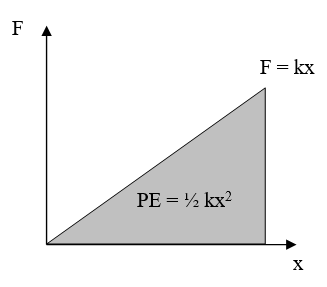
There is another way of expressing the same equation by replacing F with the spring constant
E = ½kx2
So half times the spring constant times the extension squared gives us the same value
Addition of spring constants
So the springs could be in different forms, all we need to do is think that the multiple springs acts as one huge spring
parallel spring combination
So when you place a load the force is spread out but, the extension is the same for each spring
To calculate it fast, just remember this
Ktotal = K1 + K2
A good way to remember is to think it as the opposite of adding the parallel circuit resistance
Proof
We will give a simple proof
As the force is distributed
Ftotal = F1 + F2
We can now write it in terms of kx only
Ktotalx = K1x + K2x
The x is the same for all so we can just cancel it off and get this
Ktotal = K1 + K2
Series Spring combinations
1/Ktotal = 1/K1 + 1/K2
So after finding the sum of the 1/k of each springs you finally get 1/ktotal. So you find the reciprocal to find the combined k
Remeber the Combined K would be less that the individual spring constants. Also remember it like this, it is the opposite of finding the sum of a Series circuit resistance
Proof
We know that the force exerted on each spring will be the same ( Think about tension of a rope, it's the same for all parts of the rope ). Each spring will have a different extension depending on their individual spring constants
Total extension = Extension1 + Extension2
X = F/K
F/Ktotal = F/K1 + F/K2
So as the force is common, we could remove the F out
1/Ktotal = 1/K1 + 1/K2
Remember these proofs are not neccesary but, good to remember by any chance you forget! If you don't understand there will be a video on this down below
Here is an example - each spring has a spring constant of K
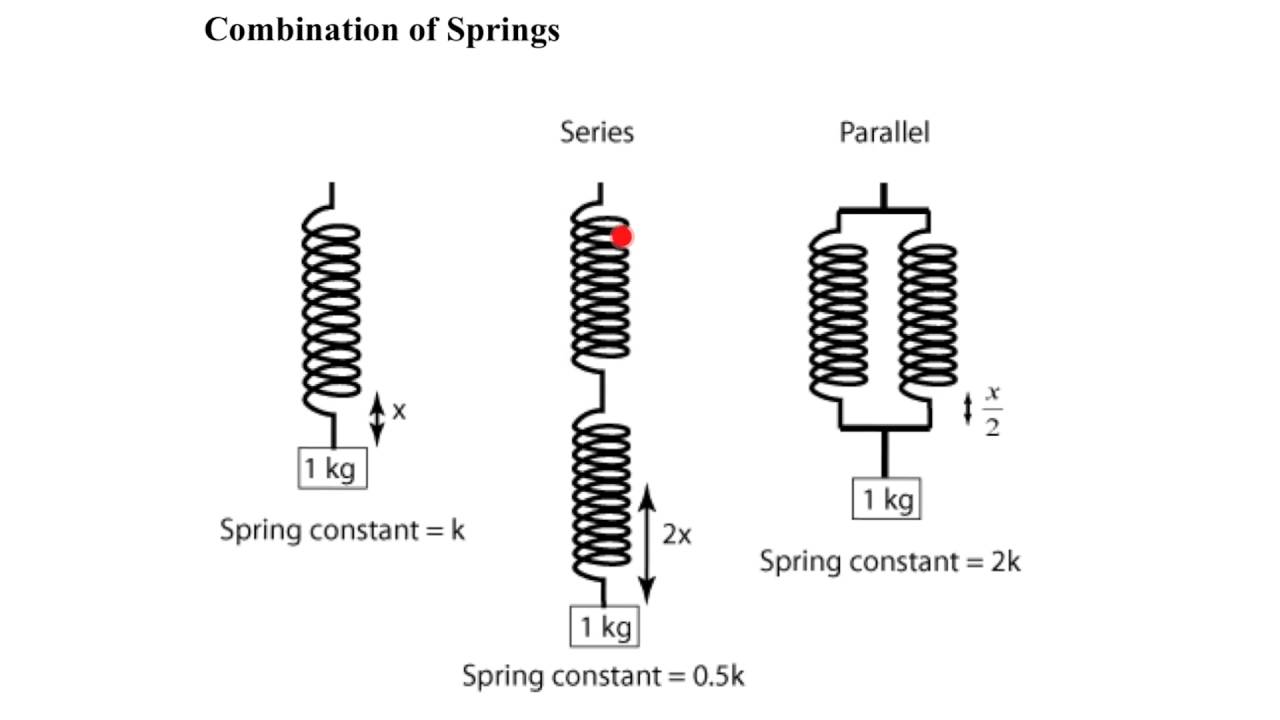
Young modulus ( E )
So we have seen above, that different thicknesses and lengths of springs are used and so we get different spring constants even if the same material is used. Think about it!
If I have a very fat spring made out of iron and a thin spring made out of iron, which is easier to pull?
So there must be a standard way of measuring the extension of a material for a given force and for a unit length and cross-sectional area. This is known as Young modulus.
It is the ratio between stress and strain
Young modulus = Stress/Strain
Let's see first what's stress and strain
Stress
The force acting on per unit cross sectional area of a wire
Stress = Force/Cross-Sectional area
Stress = F/A
As you can see, this is very similar to pressure and it shows us how much load the wire handles per unit cross-sectional area
So it has the same units as pressure : Pascals
SI units: Pa or Nm-2
I have avoided the Greek symbols for these because, it is not important
Strain
The extension per unit original length of the wire
Strain = Extension / Length
Strain = x/l
So when we apply a force to a wire, obviously it will act like a spring. And it will extend(very little). So the ratio between the extension and the original wire is called strain
It has no units as the units cancel off. It can be written off as a ratio or a percentage. However be aware that in MCQs and past papers, they sometimes give it in a percentage. So convert it first to a ratio ( by dividing by 100 ) before using it in your calculations
So now we can get Young Modulus by dividing it by strain
Young Modulus = (F/A)/(x/l)
This is same as:
Young modulus = Fl/Ax
So what does this show:
It shows the force required to extend a wire of (original) length of 1m and cross sectional area of 1m2 by 1m
So the units of Young Modulus is the same as stress as strain has no units
SI units: Pa or Nm-2
However exam question usually ask what is the estimate for the young modulus of a wire and it's usually in GigaPascal/GPa or MPa
Also remember this:
Young Modulus value is the Same for the same type of material
So even if the area or the length changes, the young modulus of a steel wire will always be the same ( at a constant temperature ) - Only the extension and the force required will change.
Stress and Strain Graphs
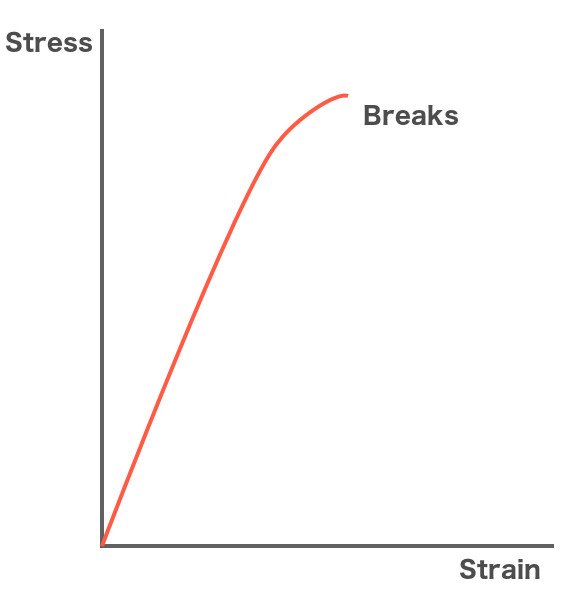
Very similar to the force-extension graph, it has a limit of proportionality.
However, the gradient represents Young Modulus
The gradient of stress and strain graph = Young modulus
The area under the graph measures the Elastic potential energy per unit volume
This is very important also:
Elastic energy per unit volume
Energy per unit Volume = ½Stress*Strain
We take half as we use the maximum stress and so we multiply by ½ to get the average. This is only used when the graph is a straight line.
It is the same as Force because, stress also increases linearly , so we get the maximum stress and divide it by 2
There are more graphs on stress and strain you need to know
Ultimate Tensile Strength
It is the maximum stress a object can handle before it breaks
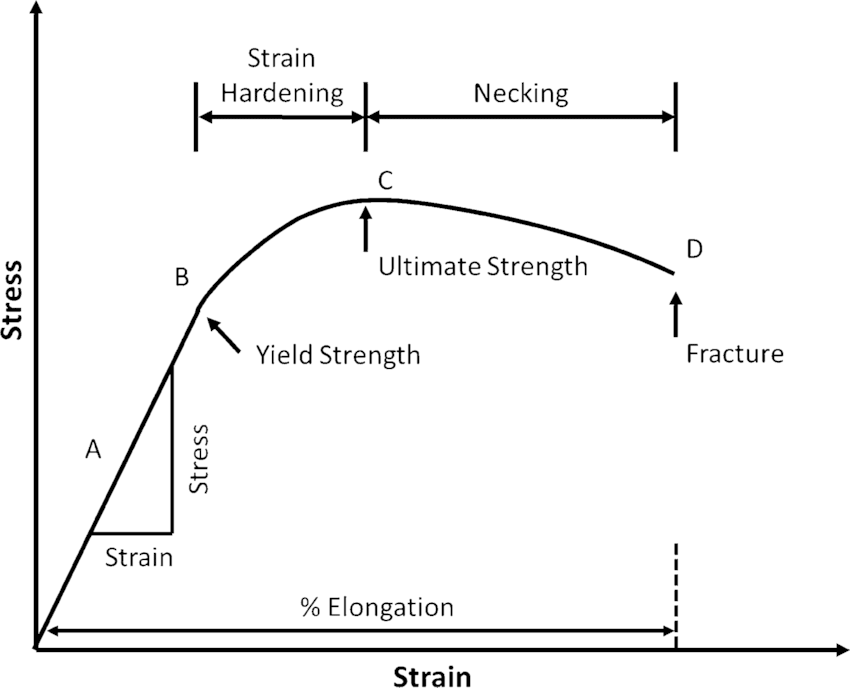
After the peak the stress decreases and the wire breaks. This is at the fracture point but, this is not needed.
Ductile or Brittle
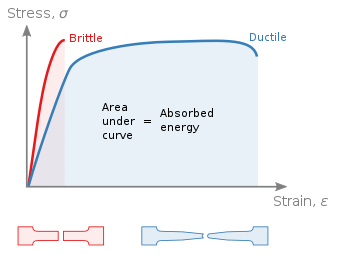
Both brittle and ductile materials follow Hooke's law, however brittle items break easily, whereas ductile material extends and plastically deforms
Work done by Springs/Wires
When we extend the spring, Elastic potential energy is stored in the spring and that's shown by the area of the force-extension graph. This is called Work done on the spring
However, when the spring is released, Work is done by the spring and if it is elastically deformed, the object comes to its original shape.
So if we put it on a graph, it will be no different as the work done on the spring is the same as the work done by the spring so the areas overlap perfectly
However, if we extend it beyond the elastic limit, the object is plastically deformed and it will keep it's new shape, so energy will be transfered out in the form of heat and so work done by the spring will be less than the work done on the spring. The difference would be the energy lost in the form of heat
Energy loss = Work done on spring - Work done by the spring
Measuring Young Modulus
We know what's included in Young Modulus
Young modulus = Fl/Ax
So we need to find each quantity
- Force/load
- Length
- Extension
- Cross sectional area
Using different standard mass such as 100g and 50g as the force
You can use a meter ruler to measure the original length of the wire. You need to measure the length from the start of the wire, (attached to a G clamp) to the point or mark/pointer on the wire
Using a travelling microscope to measure the change of length showed by the pointer on the wire
Using a micrometer screw guage to find the diameter and the area
Things to remember!
Plastic deformation graph
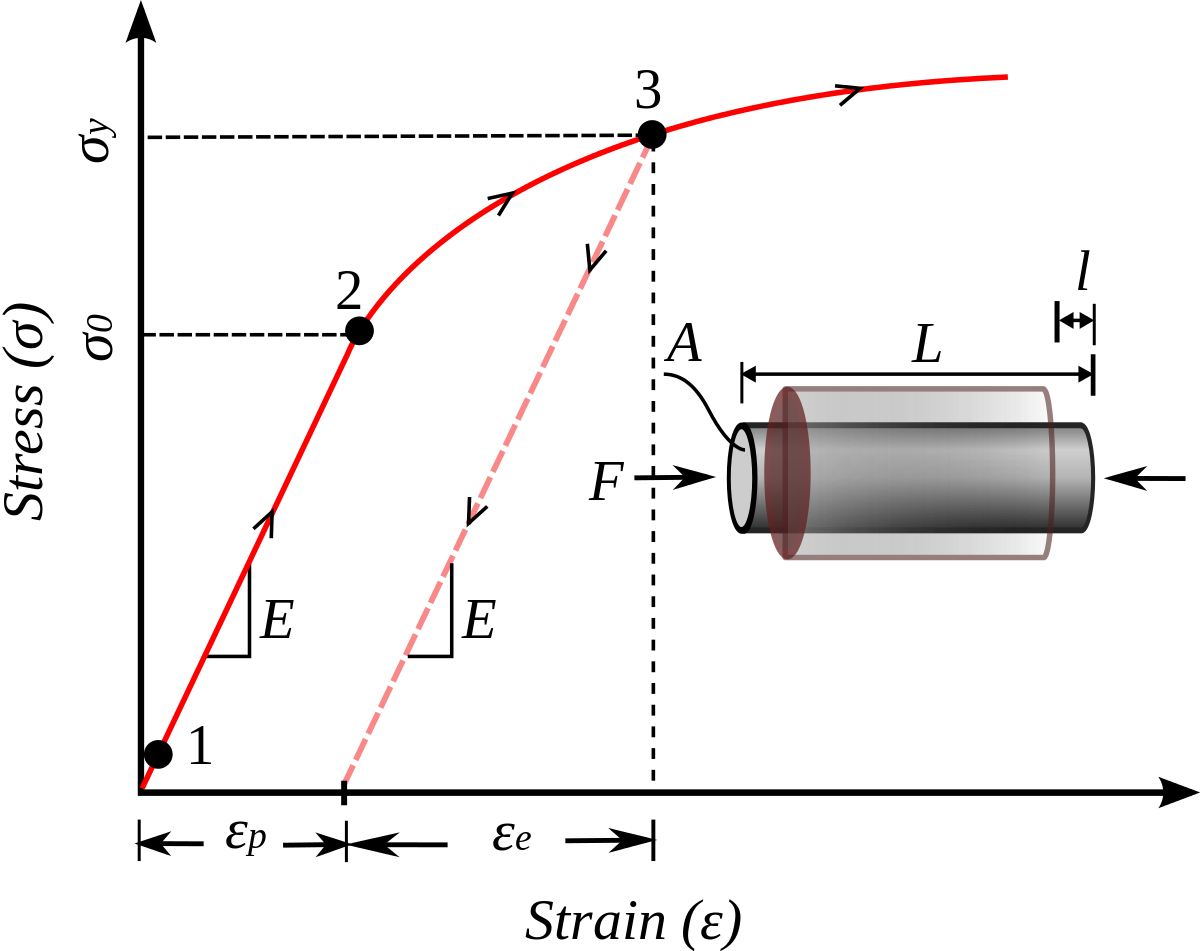
So this shows that when the wire is extended more than the elastic limit. The wire follows a new Spring constant and it decreases in a straight line. This should be remembered.
Work Lost/Wasted

Some things needed to be noted here. When we are extending the wire and removing the load, sometimes the stress-strain graph line does not overlap(non hysteresis). And so the difference in work done on the spring and the work done by the spring is the lost energy.
This is the shaded area but, as this is the stress-strain graph, this shows the heat loss per unit volume.
Moreover, you need to remember that the heat loss is for both extending and releasing the wire ( one cycle ) and not just for extending the wire.
Lastly, keep this in mind too!
You should use thin wires instead of thick ones as thin wires stretch more
Use a large length of wire
Recommended
These are things you might like. Clicking these ads can help us improve our free services in the future...
End of Chapter Videos
Collection of Videos to Support Your Understanding.
Remember these videos are handpicked by me and I feel these are the best ones out there. But I constantly update this list for each chapter. The Youtubers are more than welcome to contact me.
Also, don't forget to Subscribe to our Youtube channel - MrWik
Watch
